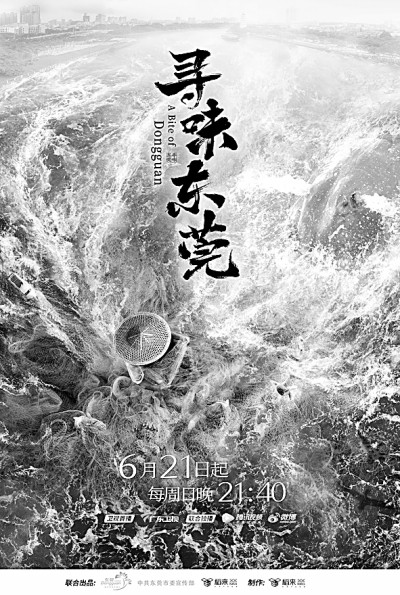

Recently, the second season of "Flavor World" and the broadcast of "Looking for Dongguan" have once again teased the taste buds of diners and aroused people’s imagination of food. The second season of "Flavor World" starts from a global perspective, and explores the inextricable connection of cuisines around the world and presents the fresh taste of cuisines around the world. "Looking for Dongguan" is based on the authentic food flavor of Dongguan, showing the local food style from three angles: adapting to the weather, relying on mountains and rivers, and migrating and blending. It outlines the local fresh people and things with food, and then reveals the original appearance of Guangdong food culture, showing the historical change and time-space collision behind the flavor circulation.
Under the mode of creating and broadcasting "internet plus Documentary", food has become an important theme. Documentaries such as "Flavor World" and "Everything Nourishes" have become "traffic", "online celebrity" and "explosion" with the help of the power of the Internet, realizing brand marketing and genre creation. By means of defamiliarization, daily aesthetics and drama, these documentaries have re-endowed the life style and cultural heritage at the image level, transformed the daily life of ordinary people into an important cultural phenomenon in China society, and promoted cultural inheritance and innovative development by means of contemporary Internet platforms and audio-visual media.
The production mode of "high concept" and the audio-visual presentation of "film texture" are surpassing the domestic food documentary.
In recent years, several major Internet video platforms have successively launched documentaries on food themes. Popular topics, unique perspectives, and escalating audio-visual means ignite the public’s enthusiasm for watching, and almost every food documentary will become a hot topic. This successful documentary type provides inspiration and experience for us to think and explore how to develop the quality construction of audio-visual works.
Judging from these successful experiences, high-quality products include the continuous innovation of audio-visual technology and concepts, the shaping and promotion of cultural product brands, and the mainstream and sharing of value systems. Take "Flavor Room" as an example, the total broadcast volume of "Flavor Room" in Tencent video in the first two seasons alone is close to 2 billion yuan. In addition, Tencent launched the urban food documentary "Looking for Dongguan" immediately after the end of the second season of "Flavor World", and used the lens to show the audience the migration of Dongguan people and the changes and changes on their dining tables. Other Internet video platforms, such as bilibili, have also started a series of work non-stop after the successful broadcast of A Life Series in the first season.
In addition to the continuous development of food content, these documentaries draw lessons from the production mode of "high concept" and pursue the audio-visual level of "film texture". Close-ups with shallow depth of field and aerial photography with special perspectives reflect the pursuit of spectacle effect in Internet documentaries. These comparable film quality and carefully selected shooting themes together constitute spectacle viewing effect, which has become an important driving force for documentary films to improve quality and market performance in recent years.
For example, the first paragraph of the first season of "Flavor Man" shows the life and diet of nomadic people in Kuerte, Xinjiang. The film shows in detail the process of freezing and growing ice crystals in horse intestines after the sudden drop of temperature at night in winter. In "Looking for Dongguan", the footage of fishermen fishing at night and people drying raked radishes changed from near to far with the shooting environment at that time, which instantly raised the details of daily life to a higher perspective and brought a powerful shocking effect to the ordinary food life.
This special shooting technique, which is specially designed according to the ingredients and production process, widely exists in most story paragraphs of this series of documentaries, and has become a new visual technology benchmark for food documentaries and a typical element used to represent audio-visual quality and viewing experience during publicity and promotion. It can be said that the level of serialization and spectacle of China’s food documentaries is approaching or even surpassing that of overseas TV stations, and other mature documentaries have become the benchmark of film and television quality creation.
It not only has cross-cultural penetration, but also is an important support for the inheritance and development of Chinese civilization in the contemporary era.
Food is not only a big IP of current Internet documentaries, but also an important symbol of China traditional culture. Long before the popularity of food documentaries, Chinese restaurants have opened all over the world and become the first window for many foreigners to know about China. With the audio-visual media becoming the most popular form of mass communication in the world, it has become a global phenomenon to understand China culture through audio-visual and food practice. Flavor Origin is the first documentary of China team that landed in Netflix, and a series of short videos on food topics released by online celebrity Liziqi on overseas platforms have also promoted the cross-cultural communication of China culture.
Popular food documentaries not only introduce China’s diet with spectacular images and dramatic stories, but also use diet as a means to explore the world outlook, values and choices of lifestyle and interpersonal relationships belonging to China culture in a way that can be understood by contemporary and even world audiences. From the perspective of dietary anthropology, many cultural groups attach their unique feelings and concepts to the daily behavior of diet; Things not only define the social identity of individuals, but also convey a lot of information such as cultural habits and lifestyles. After the broadcast of China on the Tip of the Tongue, the popularity of "Tongue Tip" in social short videos and a large number of social discussions around food documentaries have proved that such documentaries have profoundly influenced the public’s imagination about their own culture, and even shaped and strengthened their shared life experiences and shared cultural patterns.
In these audio-visual narratives about food culture, two kinds of cultural concepts have been loved by audiences at home and abroad. First of all, the traditional culture of China attaches importance to family affection, and the family has become an individual’s safe haven and gas station. This is not only the success of food documentaries that can constantly stir the heartstrings of China audiences, but also makes foreign audiences, especially those in Southeast Asia, feel familiar and close. Secondly, the familiarity and respect for everything in the world embodied in the food culture conveys the harmonious relationship between individuals and the world, and renders the connection between people and plants and mountains and rivers. These cultural elements and value systems not only have cross-cultural penetration, but also can be accepted by modern life, which is an important support for the inheritance and development of ancient China civilization in the contemporary era.
Documentary scenes and scenes full of life texture bring ordinary people’s daily life to the foreground.
Another noteworthy feature of food documentary is that it is one of the few audio-visual works that insists on telling the daily stories of ordinary people. Although there are many international chefs and elites in the film, ordinary people are undoubtedly the main body in this kind of documentary, and their lives are often the most concerned and appreciated part of the audience. It has realized the people-centered creative requirements in the current field of literature and art in a quiet way, so that the daily struggle of ordinary people has gained its due position in the presentation of mass media.
In the cultural category of "elegance and vulgarity" or "high and low", food is a typical popular culture that comes from the daily life of ordinary people and is based on oral instruction. In the documentary scene, Internet documentaries restore food to the daily meals of every ordinary family, paying attention to seasonal ingredients, regional natural ecology, and family concepts and kinship behind food processing and enjoyment, and activating the inherent beliefs of ordinary people about daily life such as "eating at home", "the taste of mom" and "the most common and delicious". In particular, films such as A String of Life, Breakfast in China and Wondering about Dongguan have opened up another "technical route" that highlights the "fireworks" in addition to the image style of wonders, accommodating more documentary scenes, daily dialogues and even seemingly unrelated chats, which are full of life texture.
Ordinary people coming to the front of the film not only vividly show how China people extend their historical traditions to their present lives, but also help other cultural groups to overcome obstacles and barriers and get to know the real China people and China culture in the context of contemporary life. Compared with movie stars and development achievements, the ordinary life of ordinary members of society also has the value of cross-cultural sharing; A meal, rice, oil and salt can often stimulate the understanding of life under different appearances, bringing true mutual understanding and beauty.
(Author: Jun-jian Liang, Associate Professor, School of Journalism and Communication, Tsinghua University)
关于作者